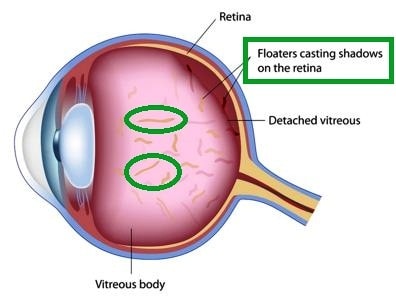Floaters in the Eye (Eye Floaters)
What are Floaters in the eye?
Floaters in the eye are distinct condition when floated tiny “cobwebs” or specks developed in the vision field. These specks are not painful and do not interfere in the vision. When individuals particularly focused on the spot, then they often feel the spots as dust particles.
The shape of these dark colored shadowy specks differs from individual to individual. Some describe as rounded spot or thread like structure or curved lines. The shape of the floaters even change with time. These floaters are not visible at the dark or when eyes are closed. It is prominent in the vast vision, especially with light coloration like when they focused on day sky.

Image 1: Floaters in Eye
In usual cases, people are not worried about this condition and mostly they ignore it. But if the number of spots is increased, then it will be an indication of serious visionary issue.
Usually these floaters are developed due to detachment of the small section of vitreous from the retina. This incidence is termed as a vitreous detachment and not interferes with vision. This condition arises suddenly and gradual progression in uncommon.
Sudden increment of the floaters numbers occurs in case of retinal detachment. Retinal detachment is a serious vision problem which needs immediate ophthalmologic assistance. Retinal detachment means a small fraction of the retina is pulled from its original position and settled at the rear side of the eye.

Image 2: Types of Floaters in the eye
The specifications of these floaters are feeling of light flashing in the eye or sudden loss of vision. Untreated condition leads to a permanent visionary problem, which is followed to blindness within two to three years.
What Causes Floaters in the eye?
Older age
The development of the floaters is due to collagen accumulation. The back chamber of the eye is filled with vitreous humor, which is a jelly like substance and formed by numerous collagen fibers. With older aged people, these collages become contracted and attachments between them become loose. This makes the collagen separated out which are then gathered in the vitreous.
In older aged people, the vitreous gel is not completely filled the back compartment of the eye, as they shrink. The space is not compactly filled with vitreous humor and often draws from retina and makes a vacant space. The detached collagen fibers can move without restraint in the vitreous humor. This is usual with older aged people at age between 50 to 75, but this can happen at any age, mainly who have nearsighted visionary problem or after cataract operation.
Diabetes
The diabetic patients have great chances for development of diabetic retinopathy and they also have a chance to development of the cataract, at an early age than the normal. Both these eye conditions may initiate or followed floaters in the eye.
Deposition of crystals
Crystals or similar deposition when deposited at the vitreous gel, then also similar symptoms arise.
Abnormality in retina
The two serious eye problems associated with retina are retinal detachment and tearing of retina. Both these conditions are related with floaters in the eye, as a symptom of the condition.
Infection and autoimmunity
Viral and fungal infection at the retina or in the vitreous gel causes local inflammation, which can lead to floaters in the eye. An autoimmune condition which causes development of the inflammation inside the eye is another promoting factor for the floaters formation in the eye.
Migraine
The typical symptoms of floaters in the eye do not match with migraine visual aura. But a similar type of condition is associated with migraine headache. Scintillating or kaleidoscope-type optical outlines with some visible movement are associated with migraine which is quite similar with floaters in the eye.
Other causes
In rare cases the other eye problems such as eye tumor or lymphoma and eye injury cause floaters in the eye.
How to Get Rid of Floaters in the eye?
In usual cases, the floaters in the eye need not to treat, as in maximum cases, they are not interfering with vision and people are less bothered. Many times, naturally they are disappeared.
- The usual treatment process is not based on evidence based as lack of clinical trial provide data about the efficacy of the treatment measures which include intake of vitamin, iodine containing drugs and some herbs.
- In case of infection associated inflammation can be treated with antibiotics and anti-inflammatory drugs for reduction of infection, but rarely medicine is prescribed for floaters in the eye.
- In case of floaters developed due to vitreous bleeding, which a symptom of retinopathy or retinal tearing can be settled with increased blood absorption and medical assistance to settle the associated problem.
- Vitrectomy is the surgical process which is conducted only when floaters in the eye interfere with the vision.
Eye Floaters Pictures

Image 3 – Patients Guide to estimate Floaters size

References
- http://www.allaboutvision.com/conditions/spotsfloats.htm
- http://www.mayoclinic.org/diseases-conditions/eye-floaters/basics/definition/con-20033061
- https://nei.nih.gov/health/floaters/floaters
- http://www.medicinenet.com/eye_floaters/article.htm
- http://www.webmd.com/eye-health/benign-eye-floaters
